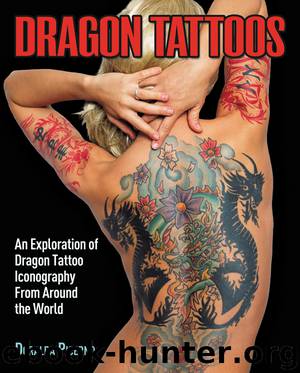Dragon Tattoos by Doralba Picerno

Author:Doralba Picerno
Language: eng
Format: epub
Publisher: Arcturus Digital Limited
EUROPEAN DRAGONS
Although the iconography of Eastern dragons dominates modern fashion and skin art, Europe also has its own strong dragon tradition. Dragons have populated European fairytales for centuries, as part of a rich heritage which includes myths such as that of the nine-headed hydra. Many of these legends predate Christian literature.
In early Christian texts, creatures resembling dragons are used to represent Satan. The dragon’s negative and destructive connotations in folk tales and myths from the Dark Ages is undoubtedly the result of its Christian demonic heritage.
The European dragon differs significantly from its Eastern counterpart. It appears as a huge lizard with bat-like wings and horns; and it breathes fire, which it often uses as a weapon to devastating effect. Another recurring image is that of the Ouroboros (literally meaning ‘eating its own tail’), a dragon deity first found around 1600BCE in ancient Egypt. This alchemical motif of the snake/dragon in a circle symbolizes the life cycle of death and rebirth.
A beautiful black and grey design which works its way across the back and round the right leg. Tattoo by Spacey, Bizarre Ink, Edinburgh, UK Fire-breathing and menacing, this dragon spreads its wings ready to attack. Tattoo by Mario Katulacs, One More Tattoo, Luxembourg St George spears the dragon in this tattoo by an unknown artist A dragon with giant wings, spikes and fangs glowers from this menacing black and grey back piece. Tattoo by Miss Nico, All Style Tattoo, Berlin, Germany T
he majority of mythological and pictorial references to dragons date back to the Middle Ages, an era of unrest, war and disease. During this period, dragons allegedly became extinct; they were all slain by courageous knights intent on proving their worth and making a name for themselves. The most famous of these legends sees St George slay a malevolent dragon. This story was probably adapted from ancient Greek myth or even from a popular Middle Eastern tale brought back by the Crusaders. The story seems to have more than a passing resemblance to folk legends, which were later elaborated upon in fairytales: a princess is offered to a dragon to appease its rage, St George intervenes and rescues the maiden in distress by killing the dragon. During the Middle Ages, it appears that every period of deep misery and famine was attributed to the malign influence of a dragon – an early example of the way in which rulers and feudal landowners used false propaganda to escape accusations of negligence.
The role of dragon-vanquisher did not belong solely to intrepid knights: St Martha, for example, earned her sainthood by tackling the dragon that was afflicting the French town of Tarascon. In the Bible, Martha, sister of Lazarus, left her village after Jesus’ death and settled in Provence. Legend has it that she travelled further and in the year 48ce reached a village where the Tarasque, a dragon-like creature related to the Leviathan, was terrorizing the locals. However, she did not kill it, but charmed and tamed it, in a manner reminiscent of the Beauty and the Beast story.
Download
This site does not store any files on its server. We only index and link to content provided by other sites. Please contact the content providers to delete copyright contents if any and email us, we'll remove relevant links or contents immediately.
| Body Art & Tattoo | Calligraphy |
| Ceramics | Conceptual |
| Digital | Erotic |
| Film & Video | Glass |
| Graffiti & Street Art | Illuminations |
| Installations | Mixed Media |
| Mosaic | Prints |
| Public Art | Video Games |
Kathy Andrews Collection by Kathy Andrews(11726)
Thirteen Reasons Why by Jay Asher(8791)
The Red Files by Lee Winter(3367)
How to Do Nothing by Jenny Odell(3232)
The Genius of Japanese Carpentry by Azby Brown(3223)
Stacked Decks by The Rotenberg Collection(2810)
Tattoo Art by Doralba Picerno(2599)
Champions of Illusion by Susana Martinez-Conde & Stephen Macknik(2414)
The Artist's Way Workbook by Cameron Julia(2195)
The Art of Doom by Bethesda(2106)
Calligraphy For Dummies by Jim Bennett(1990)
Creative Character Design by Bryan Tillman(1888)
Botanical Line Drawing by Peggy Dean(1809)
Wall and Piece by Banksy(1778)
The Art of Creative Watercolor by Danielle Donaldson(1777)
One Drawing A Day by Veronica Lawlor(1767)
Art Of Atari by Tim Lapetino(1737)
Pillars of Eternity Guidebook by Obsidian Entertainment(1622)
Happy Hand Lettering by Jen Wagner(1556)
